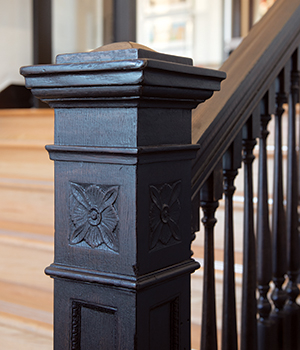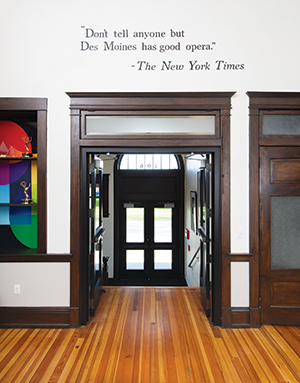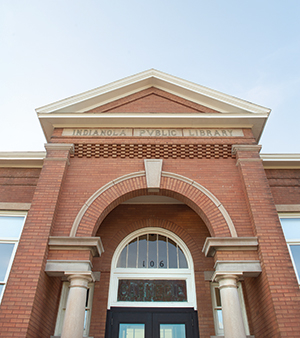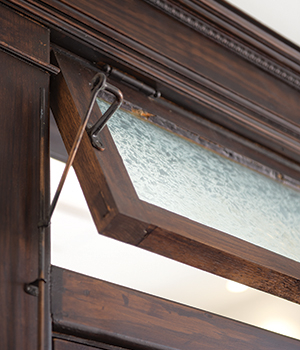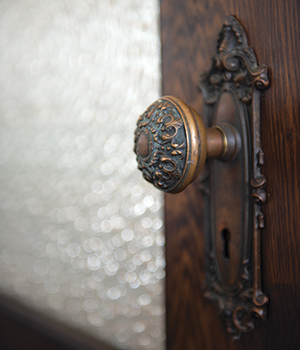Above: A two-story glass atrium is the showpiece of the renovation and expansion at the Indianola home of Des Moines Metro Opera.
Writer: Luke Manderfeld
Photographer: Duane Tinkey
Michael Egel gets stopped around Indianola much more frequently these days. At the grocery store, community functions or downtown on a walk, the general and artistic director of Des Moines Metro Opera has been approached by strangers who gush about the renovation and expansion of the company’s offices in the onetime Carnegie Library there.
Located down the street from Simpson College and in the heart of Indianola’s business district, the newly named Lauridsen Opera Center—completed in late May—has a way of commanding attention to its glass atrium addition. Floor-to-ceiling windows frame a view of the original building’s red brick exterior, now under glass, and of opera costumes held aloft on display.
“First they ask, ‘Are you the guy who runs the opera company?’” says Egel, who has directed DMMO since 2013. Then he smiles. “They say, ‘Every time I walk or drive by, I see the windows. I love them.’ There’s so much interest around town.”
The renovation was some six years in the making. In 2012, DMMO, which has owned and operated its offices out of the 115-year-old Carnegie building since the mid-1980s, looked into the long-term viability of the space and considered moving elsewhere in Indianola.
But for a locally minded organization like DMMO, the Carnegie building was the right place to be, Egel says. Its historic significance and emotional ties to the community were the anchors that held DMMO there. In 2016, the company launched a $3.5 million fundraising campaign to renovate the space and add the atrium.
The decision to stay in place was a big win for the community and the widely acclaimed DMMO, which is considered a hidden gem by critics and opera enthusiasts nationally and abroad.
“The building is unique in its origin, and it’s appropriate that something as unique as [DMMO] is housed there,” says Ryan Waller, city planner for Indianola. “For them to invest in the long-term future here is extremely exciting for us. The feedback from the community has been exceptional.”
Widespread Support
When DMMO asked Ardene Downing if she’d help chair the fundraising committee for the renovation and expansion, she was hesitant. As an active community leader, Downing was already involved in several local organizations in addition to her commercial real estate business.
But after a little encouragement from her husband, she took the role. And she’s glad she did.
“It was so exciting to work on the campaign because it was so well received,” Downing says. “We’re really proud of [DMMO], and raising money for the renovation wasn’t difficult at all. People were very responsive.”
Individual donations during the campaign ranged from as little as $25—sometimes as unexpected checks in the mail—to $1 million, donated by Virginia and Nix Lauridsen, who became the building’s namesakes.
The city of Indianola was in step with DMMO all along the way. Egel says the city helped raise more than $1 million.
All told, DMMO raised more than $4 million, breaking its $3.5 million goal. Ground was broken in April 2018.
“The most remarkable part,” Egel says, “was the generosity, passion and speed that people stepped up and said, ‘Yes, we believe in Des Moines Metro Opera.’ ”
New and Old
In addition to adding space, an important goal of the project was to blend the charm of the 1904 library building, which is on the National Registry of Historic Places, with modern architecture and contemporary style. That focus is evident in the atrium, which added 1,800 square feet of event space to the building.
The two-level expansion shines. Des Moines Metro Opera’s logo hangs on one wall, lit up with the rest of the atrium at night. Display cases on the ground floor and above the two stairways showcase opera costumes and memorabilia. A new ground-level entrance and large elevator ensure that the building is accessible to everyone.
The original structure remains intact. As you stand in the atrium looking at the red brick ediface, it’s easy to think you’re outside—and you would have been before the expansion.
“We wanted to keep that original building as intact as possible,” says Scott Allen, an associate at OPN Architects in Des Moines. “We ultimately decided to keep the expansion and building separate with a doorway, and I think that provides a unique experience.”
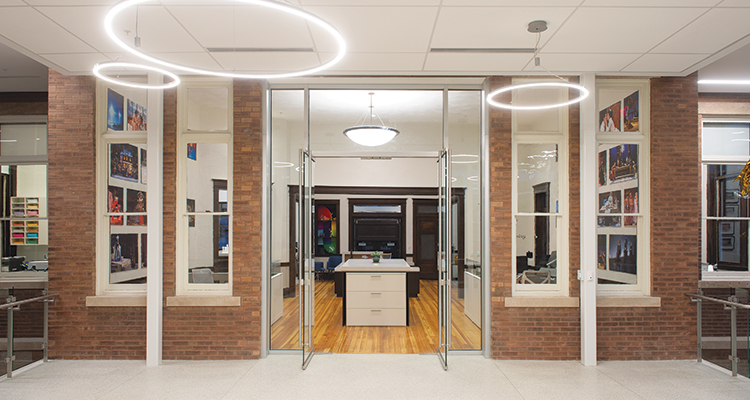
Modern glass doors mark the transition from the new addition into the original building.
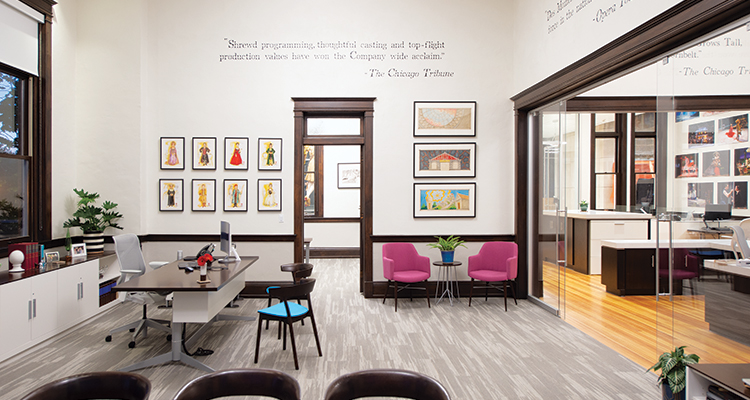
Old and new merge in the furnishings and decor of the opera’s offices.
Inside the original building, the style is minimalistic. Collaborative tables are focal points of the various rooms, and the surrounding desks are adjustable in height. The conference room features a table original to the building. A sleek new downstairs kitchen offers space for events or for employees to relax. The rehearsal room on the south side of the building now has soft flooring, providing more comfort for performers.
Outside, the foliage complements the expansion. A rain garden—which doubles as a stormwater collection system—sits at the northwest corner of the building and provides an organic touch.
“The building is very tastefully done,” Waller says. “When you walk through, you can see it’s been renovated, but the historic nature of it is still extremely prevalent. It’s a great blend of the history and future.”
Throughout the Lauridsen Opera Center, visitors will find artwork, displays and collections steeped in history. Egel says it was important for the building to pay homage to DMMO’s roots while also looking toward the organization’s future.
“My hope is that is that this building will speak to a mature organization going into a new phase of its existence,” Egel says. “The organization is mindful of its history, but we are also very forward-looking.”
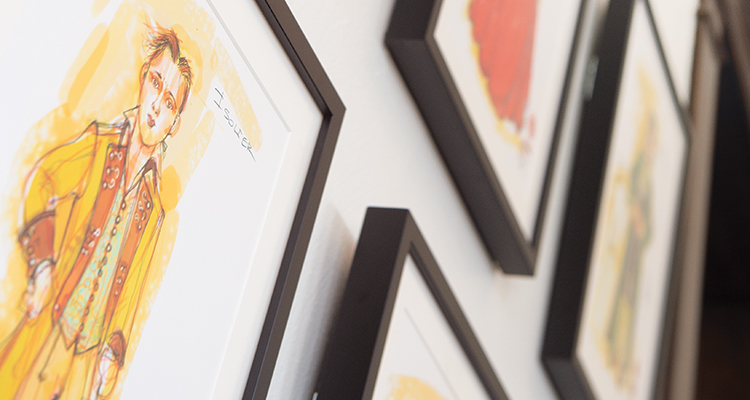
Michael Engel found hundreds of original paintings and drawings stuffed in drawers. He framed and hung them all over the offices.
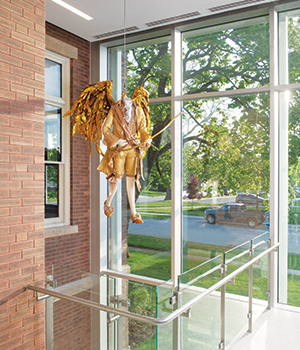
The new atrium is all dressed up in opera costumes, ready for visitors to a series of events here this summer.
DMMO is now turning its attention to the organization’s 50-year anniversary in 2022. The Lauridsen Opera Center is the ideal kickoff point for DMMO as it heads toward that milestone.
“At every turn, every aspect has exceeded my wildest expectations,” Egel says. “I’m very excited to feature the legacy of this building while bringing in the atrium and the welcome mat it provides to the community of Indianola. We can reintroduce ourselves to a new generation of Indianola as we move toward 50 years as an organization.”

Des Moines Metro Opera’s 2019 Season
“La Bohème”
Composer: Giacomo Puccini
Dates: June 28, 30; July 5, 11, 13, 21
“La Bohème” follows a group of struggling bohemian artists in 19th-century Paris. A hundred years after its premiere, the popular opera was adapted into the musical “Rent,” a Broadway blockbuster.
“Candide”
Composer: Leonard Bernstein
Dates: June 29; July 7, 10, 12, 20
Based on a French satire first published in 1759 by Voltaire, “Candide” is a witty operetta described as “part opera, part musical and entirely irreverent.”
“Wozzeck”
Composer: Alban Berg
Dates: July 6, 14, 16, 19
Taking place in rural Germany in the early part of the 20th century, the opera tells the story of a poor soldier who’s afflicted with horrific visions and consumed with jealousy over his lover’s lie, which ultimately leads to tragedy.
“Bon Appétit!”
Composer: Lee Hoiby
Dates: July 18, 19, 20
(Sold out)
As part of its Second Stages Series, DMMO is collaborating with the Iowa Culinary Institute at Des Moines Area Community College to provide dinner, dessert and a performance of Lee Hoiby’s “Bon Appétit!,” which is based on a televised 1961 cooking lesson by Julia Child on how to make decadent chocolate cake.


